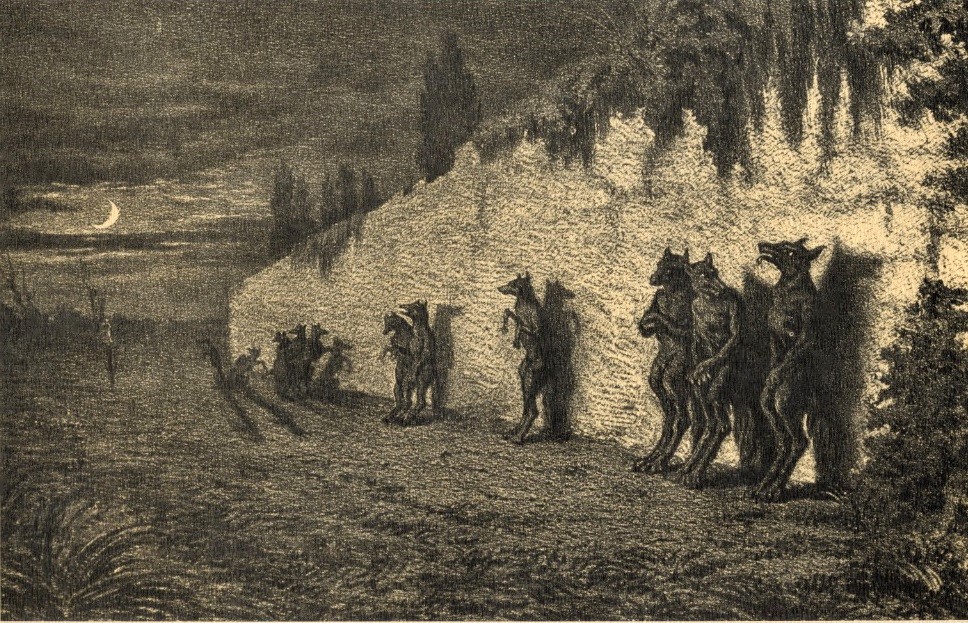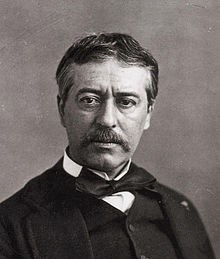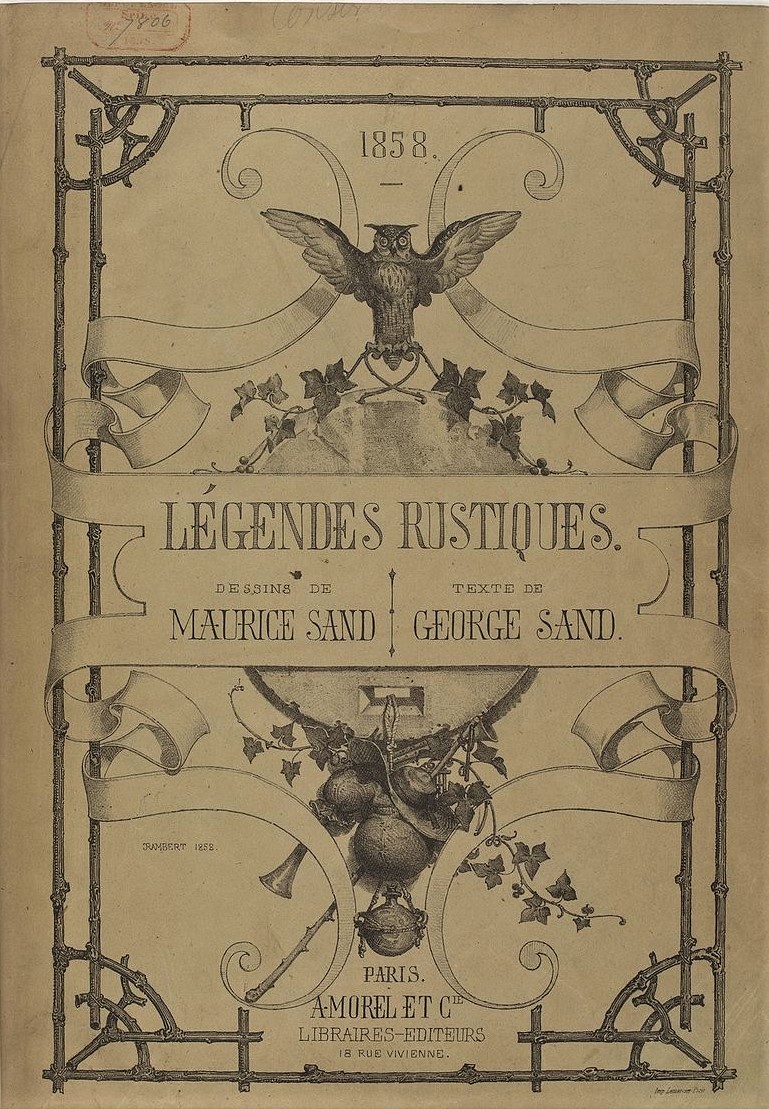
Grove Koger
In my July 1, 2018, post about the winter that French writer George Sand and Polish composer Frédéric Chopin spent on the island of Majorca, I mentioned that the couple were accompanied by Sand’s son, Maurice, and reproduced his drawing of one of the houses that the party leased. It was while researching the subject further that I realized I was actually familiar with another of Maurice’s works.
One of my purchases at Boise’s Book Shop when I was young was The Werewolf by Montague Summers (1880-1948), an exhaustive investigation of what Summers called “that most terrible and depraved of all the bond slaves of Satan.” I actually found Summers’ book a little dry—fun to dip into but not the kind of thing I cared to read from cover to cover. However, it contained a frontispiece that has remained in my mind’s eye for decades.

The black-and-white image was labeled “Les Lupins” and was credited to one Maurice Sand. Well, that name meant nothing to me all those decades ago, but now it does. Born on June 30, 1823, and known formally as Jean-Françoise-Maurice-Arnauld, Baron Dudevant, he grew up to be a lepidopterist and writer, producing novels, now completely forgotten, and a detailed study of the commedia dell’arte. Having studied for a time under famous French painter Eugene Delacroix, he also worked as an illustrator.

One of the books that Maurice illustrated was his mother’s Légendes rustiques. (rustic legends), an 1858 collection of twelve peasants’ legends from province of Berry in central France. Maurice prepared an atmospheric engraving to accompany each one, and his contribution to the last—“Lubins ou Lupins”—shows nearly a dozen wolf-like creatures standing on hind legs and leaning casually against a cemetery wall at night.
According to George Sand’s text, which I’m adapting from a machine translation, lubins aren’t quite werewolves. “Sorrowful, dreamy and stupid spirits,” she writes, “they spend their lives chatting in an unknown language along the walls of cemeteries. In some places they are accused of breaking into the field of rest and gnawing on bones. In the latter case, they belong to the race of lycanthropes and werewolves, and must be called lupins. But in the case of lubins, manners soften with the name. They do no harm and escape at the slightest sound.”
As I’ve mentioned, Sand’s engraving is labeled “Les Lupins,” suggesting that he himself wasn’t paying too much attention to the distinction his mother was making. But as students of the field are wont to remind us, the study of lycanthropy isn’t an exact science.
The most striking aspect of Maurice’s engraving is that it’s not just ominous and unnerving, but funny as well. I grin every time I look at it. It’s a commonplace that tragedy and farce have much in common, and, in depicting these bizarre but timid creatures, the artist shows that the same is true of horror and humor.
Montague Summers (1880-1948) was an English clergyman who claimed to believe that werewolves, vampires and the like were real. He converted to Catholicism in 1909 and began to pass himself off as the Reverend Alphonsus Joseph-Mary Augustus Montague Summers, although it’s not clear that he ever took orders. A colorful, puzzling and controversial individual, he deserves an entry of his own, which I’ll be putting together this year or next.
What a great little article to read at midnight, which it is right now where I am. I too love this image produced by Maurice Sands. I have a book title ‘Strange Stories, Amazing Facts’ – a Reader’s Digest book that I grew up with that once belonged to my parents, and now I own. This image is in the book, in a chapter about Lupins. It’s now one of my favourite images, so haunting…
What I also found strange was that one of your paragraphs where George Sands describes these werewolves are exactly how I depicted them in a short story I wrote a few years ago. I used Maurice’s image to describe a scene in the tale and what you wrote about what Sand say about them described it perfectly. Almost like I’d read Sand’s book, but I haven’t. They were called lupins in my story. It’s uncanny and I’m weirded out right now.
I’d love to read her book Rustic Legends. I’ll have to buy a copy!
Thanks for this!
LikeLike
Thanks for writing! It’s intriguing how haunting that image is. My memory is that Sand’s book has never been translated into English; I think I had to use an online translation tool to read it. By the way, I ran across a reference the other day to a werewolf story by an obscure English writer that sounded a lot like one of Sand’s stories, as if he had borrowed heavily from it. Now that I’ve been reminded, I’ll try to track down some more details.
LikeLike
Hello again, I found Sands’ book ‘Rustic Legends’ for purchase last year not long after this conversation – I got it off Amazon, and have read the story, which is quite strange! I want to get this print and frame it – I found a copy of it on http://www.art.com (under ‘folklore, Lubins’, but as I live in Australia, art.com does not deliver there, so I’ll find someone I know in the US to send it to me via their house
As for the story behind it, someone on a Facebook page shared the image and talked about how George Sands saw something that inspired the tale. I’ve also been delving into the dogman stories of North America and the Loup Garou myths. Considering this ‘Loup Garou’ had been seen on every continent, it makes me really wonder what George saw… I’d love to hear about the English writers werewolf story…
LikeLike
And thank YOU.
LikeLike
Thank you for this although I was aware of the ‘Les Lupins’ image I didn’t till I found your post realise it was by George Sand’s son. In the 2012 television comedy-drama series ‘Being Human’ the incognito werewolf, played by Russell Tovey, is named George Sands. I like to think this was entirely intentional popular culture reference, especially as George Sand, like the charactor of George Sands, dressed as what they were not for ease of movement and to become invisable.
LikeLike
And thank you! Intriguing about the name in “Being Human.” Sometimes I suspect that absolutely everything in the world is tied together at some level.
LikeLike
Hello,
I have seen this image many times over the past few years. Thank you so much for all your research and links. This image always reminds me of the ‘bold’ schoolboys smoking down ‘the back field’ or outside the schoolyard wall!
LikeLike
And thank you! It’s an odd image–vaguely humorous, as you indicate, but unsettling at the same time. I smile uneasily every time I see it.
LikeLike